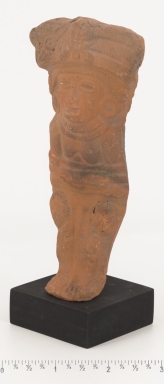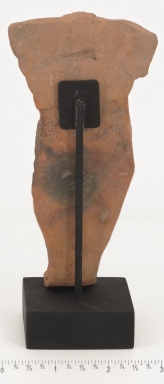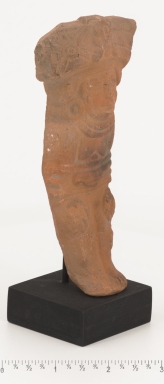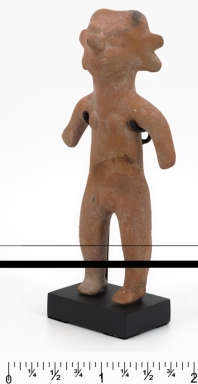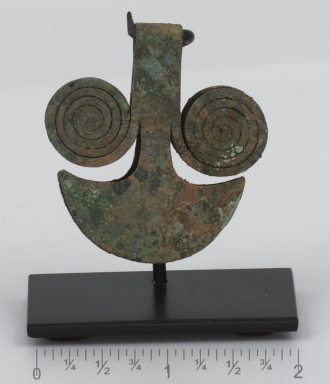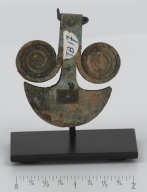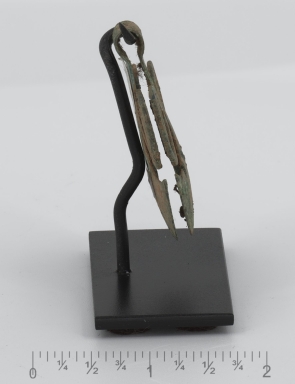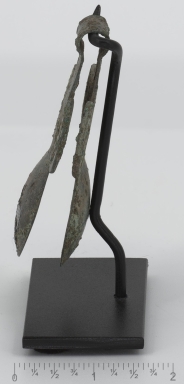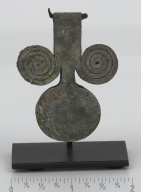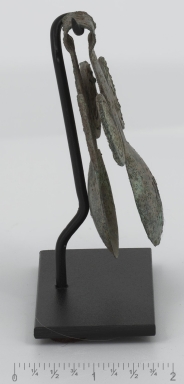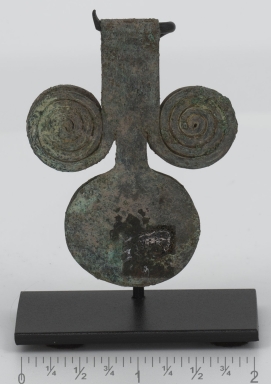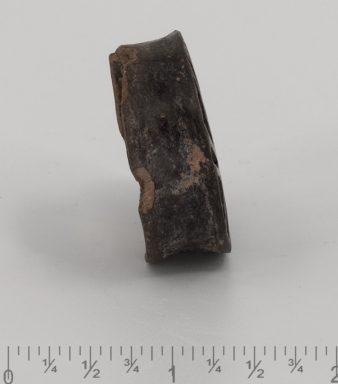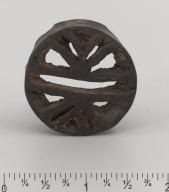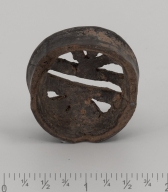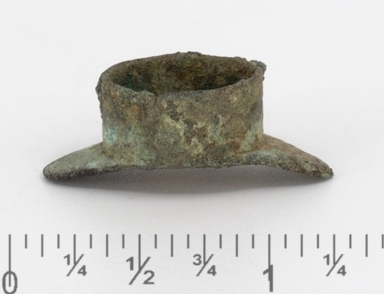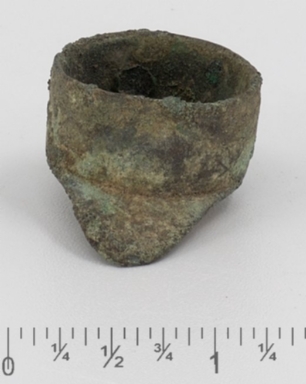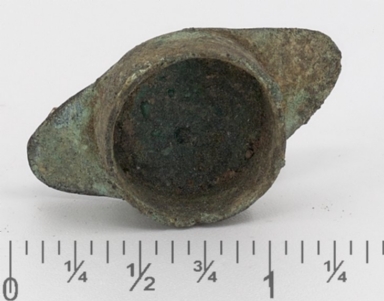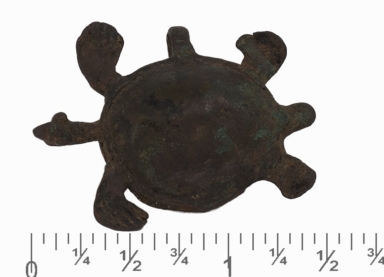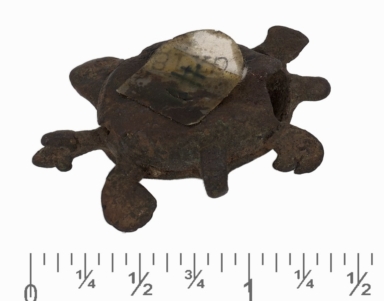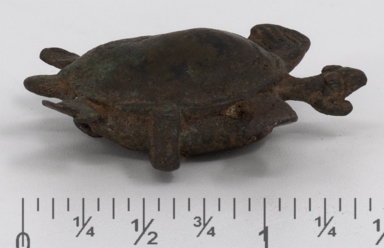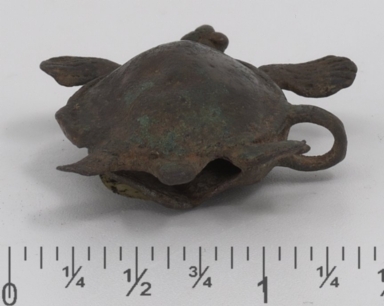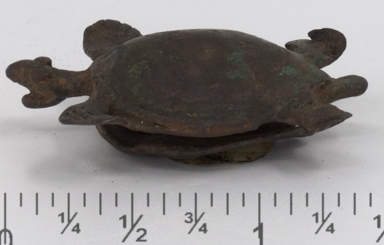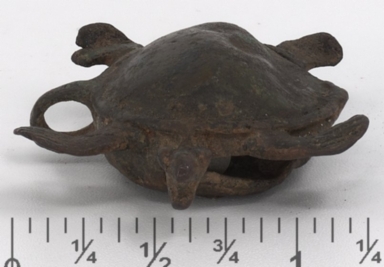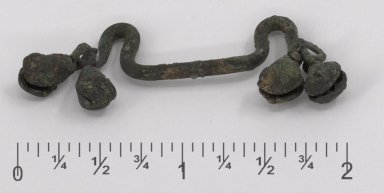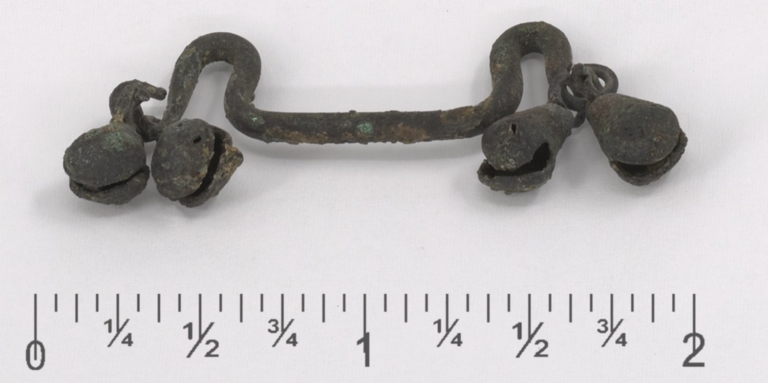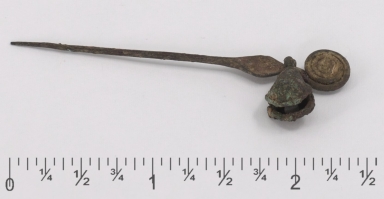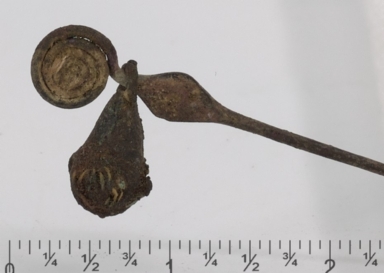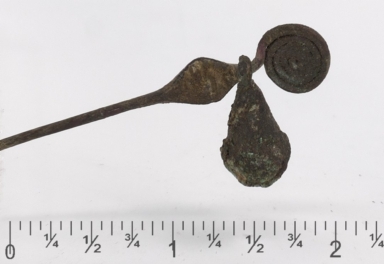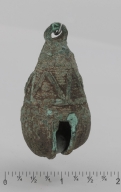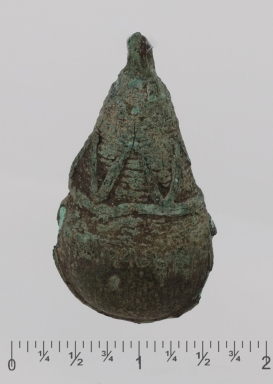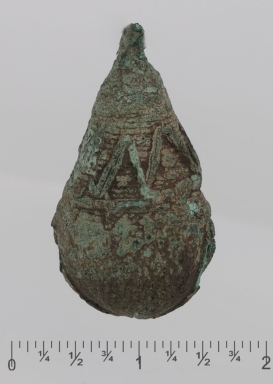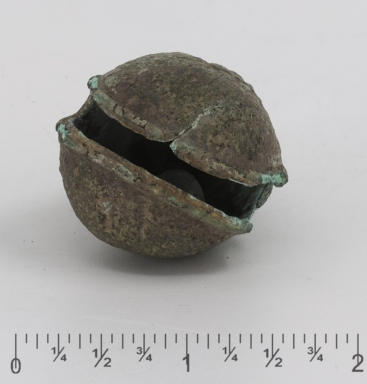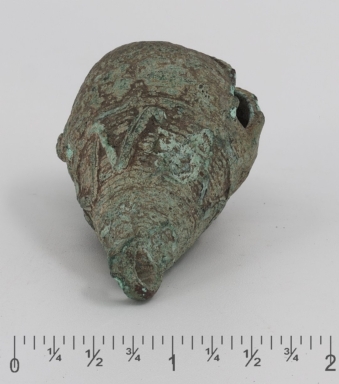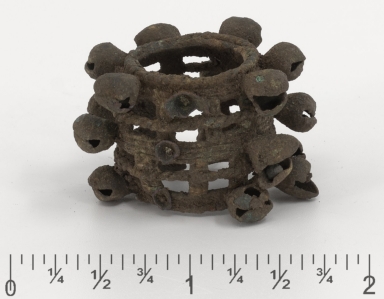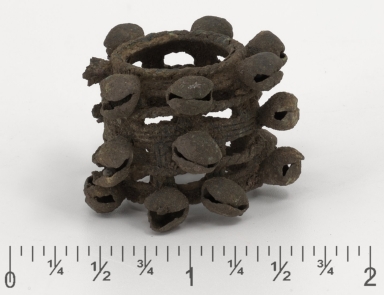|
Title
Mold made female prisoner figure.
Description
The figure's compactness and the flatness of the clay indicates press mold fabrication. The clay's details hint to the figure's meaning. The band across the abdomen suggests captive. Her headdress contains three elements: an Ollin symbol, a [blank], and three feathers, precious movement (sic).
Subject
[Toltec sculpture--Mexico, Sculpture--Mexico, Toltec art--Mexico, Indigenous peoples--Antiquities]
Date
between 900 and 1200
Title
Mold made female prisoner figure.
Description
The figure's compactness and the flatness of the clay indicates press mold fabrication. The clay's details hint to the figure's meaning. The band across the abdomen suggests captive. Her headdress contains three elements: an Ollin symbol, a [blank], and three feathers, precious movement (sic).
Subject
[Toltec sculpture--Mexico, Sculpture--Mexico, Toltec art--Mexico, Indigenous peoples--Antiquities]
Date
between 900 and 1200
Title
Mold made female prisoner figure.
Description
The figure's compactness and the flatness of the clay indicates press mold fabrication. The clay's details hint to the figure's meaning. The band across the abdomen suggests captive. Her headdress contains three elements: an Ollin symbol, a [blank], and three feathers, precious movement (sic).
Subject
[Toltec sculpture--Mexico, Sculpture--Mexico, Toltec art--Mexico, Indigenous peoples--Antiquities]
Date
between 900 and 1200
Title
Mold made female prisoner figure.
Description
The figure's compactness and the flatness of the clay indicates press mold fabrication. The clay's details hint to the figure's meaning. The band across the abdomen suggests captive. Her headdress contains three elements: an Ollin symbol, a [blank], and three feathers, precious movement (sic).
Subject
[Toltec sculpture--Mexico, Sculpture--Mexico, Toltec art--Mexico, Indigenous peoples--Antiquities]
Date
between 900 and 1200
Title
Mold made female prisoner figure.
Description
The figure's compactness and the flatness of the clay indicates press mold fabrication. The clay's details hint to the figure's meaning. The band across the abdomen suggests captive. Her headdress contains three elements: an Ollin symbol, a [blank], and three feathers, precious movement (sic).
Subject
[Toltec sculpture--Mexico, Sculpture--Mexico, Toltec art--Mexico, Indigenous peoples--Antiquities]
Date
between 900 and 1200
Title
Mold made female prisoner figure.
Description
The figure's compactness and the flatness of the clay indicates press mold fabrication. The clay's details hint to the figure's meaning. The band across the abdomen suggests captive. Her headdress contains three elements: an Ollin symbol, a [blank], and three feathers, precious movement (sic).
Subject
[Toltec sculpture--Mexico, Sculpture--Mexico, Toltec art--Mexico, Indigenous peoples--Antiquities]
Date
between 900 and 1200
Title
Standing female figure.
Description
Two side head projections help to place this Toltec figure in Post Classic Colima. Fertility is indicated by her sex. The clay surface probably was polychromed and she wore clothing or paper garments.
Subject
[Toltec sculpture--Mexico--Colima (State), Sculpture--Mexico--Colima (State), Art--Mexico--Colima (State), Indigenous peoples--Antiquities, Toltec art--Mexico--Colima (State)]
Date
between 900 and 1200
Title
Standing female figure.
Description
Two side head projections help to place this Toltec figure in Post Classic Colima. Fertility is indicated by her sex. The clay surface probably was polychromed and she wore clothing or paper garments.
Subject
[Toltec sculpture--Mexico--Colima (State), Sculpture--Mexico--Colima (State), Art--Mexico--Colima (State), Indigenous peoples--Antiquities, Toltec art--Mexico--Colima (State)]
Date
between 900 and 1200
Title
Standing female figure.
Description
Two side head projections help to place this Toltec figure in Post Classic Colima. Fertility is indicated by her sex. The clay surface probably was polychromed and she wore clothing or paper garments.
Subject
[Toltec sculpture--Mexico--Colima (State), Sculpture--Mexico--Colima (State), Art--Mexico--Colima (State), Indigenous peoples--Antiquities, Toltec art--Mexico--Colima (State)]
Date
between 900 and 1200
Title
Standing female figure.
Description
Two side head projections help to place this Toltec figure in Post Classic Colima. Fertility is indicated by her sex. The clay surface probably was polychromed and she wore clothing or paper garments.
Subject
[Toltec sculpture--Mexico--Colima (State), Sculpture--Mexico--Colima (State), Art--Mexico--Colima (State), Indigenous peoples--Antiquities, Toltec art--Mexico--Colima (State)]
Date
between 900 and 1200
Title
Standing female figure.
Description
Two side head projections help to place this Toltec figure in Post Classic Colima. Fertility is indicated by her sex. The clay surface probably was polychromed and she wore clothing or paper garments.
Subject
[Toltec sculpture--Mexico--Colima (State), Sculpture--Mexico--Colima (State), Art--Mexico--Colima (State), Indigenous peoples--Antiquities, Toltec art--Mexico--Colima (State)]
Date
between 900 and 1200
Title
Copper tweezers, crescent pinchers, spirals.
Description
The Tarascans embellished their crescent shaped tweezers with hammered spirals. They were worn as emblems of status or authority.
Subject
[Decoration and ornament--Mexico, Art--Mexico, Indigenous peoples--Antiquities]
Date
between 900 and 1200
Title
Copper tweezers, crescent pinchers, spirals.
Description
The Tarascans embellished their crescent shaped tweezers with hammered spirals. They were worn as emblems of status or authority.
Subject
[Decoration and ornament--Mexico, Art--Mexico, Indigenous peoples--Antiquities]
Date
between 900 and 1200
Title
Copper tweezers, crescent pinchers, spirals.
Description
The Tarascans embellished their crescent shaped tweezers with hammered spirals. They were worn as emblems of status or authority.
Subject
[Decoration and ornament--Mexico, Art--Mexico, Indigenous peoples--Antiquities]
Date
between 900 and 1200
Title
Copper tweezers, crescent pinchers, spirals.
Description
The Tarascans embellished their crescent shaped tweezers with hammered spirals. They were worn as emblems of status or authority.
Subject
[Decoration and ornament--Mexico, Art--Mexico, Indigenous peoples--Antiquities]
Date
between 900 and 1200
Title
Tweezers : spherical pinchers.
Description
Tweezers were very common in the Central South American Andes, but not in Mesoamerica. The elite Tarascans wore tweezers as a pendant. They probably were more than an object to remove facial hair. The tweezers were more like badge of office or status.
Subject
[Aztec sculpture--Mexico, Metal sculpture--Mexico, Art--Mexico, Indigenous peoples--Antiquities]
Date
between 900 and 1200
Title
Tweezers : spherical pinchers.
Description
Tweezers were very common in the Central South American Andes, but not in Mesoamerica. The elite Tarascans wore tweezers as a pendant. They probably were more than an object to remove facial hair. The tweezers were more like badge of office or status.
Subject
[Aztec sculpture--Mexico, Metal sculpture--Mexico, Art--Mexico, Indigenous peoples--Antiquities]
Date
between 900 and 1200
Title
Tweezers : spherical pinchers.
Description
Tweezers were very common in the Central South American Andes, but not in Mesoamerica. The elite Tarascans wore tweezers as a pendant. They probably were more than an object to remove facial hair. The tweezers were more like badge of office or status.
Subject
[Aztec sculpture--Mexico, Metal sculpture--Mexico, Art--Mexico, Indigenous peoples--Antiquities]
Date
between 900 and 1200
Title
Tweezers : spherical pinchers.
Description
Tweezers were very common in the Central South American Andes, but not in Mesoamerica. The elite Tarascans wore tweezers as a pendant. They probably were more than an object to remove facial hair. The tweezers were more like badge of office or status.
Subject
[Aztec sculpture--Mexico, Metal sculpture--Mexico, Art--Mexico, Indigenous peoples--Antiquities]
Date
between 900 and 1200
Title
Pierced blackware ear spool.
Description
Red-brown clay was probably pressed into a circular mold and allowed to become a leather hard disc. The disc has curved concave sides for wearing as an earspool. The disc was pierced with a bilateral radiating design. The pierced ear spool was fired in a reduced carbon friendly environment
Subject
[Ceramic jewelry--Mexico, Decoration and ornament--Mexico, Mixtec art--Mexico, Indigenous peoples--Antiquities]
Date
between 900 and 1200
Title
Pierced blackware ear spool.
Description
Red-brown clay was probably pressed into a circular mold and allowed to become a leather hard disc. The disc has curved concave sides for wearing as an earspool. The disc was pierced with a bilateral radiating design. The pierced ear spool was fired in a reduced carbon friendly environment
Subject
[Ceramic jewelry--Mexico, Decoration and ornament--Mexico, Mixtec art--Mexico, Indigenous peoples--Antiquities]
Date
between 900 and 1200
Title
Pierced blackware ear spool.
Description
Red-brown clay was probably pressed into a circular mold and allowed to become a leather hard disc. The disc has curved concave sides for wearing as an earspool. The disc was pierced with a bilateral radiating design. The pierced ear spool was fired in a reduced carbon friendly environment
Subject
[Ceramic jewelry--Mexico, Decoration and ornament--Mexico, Mixtec art--Mexico, Indigenous peoples--Antiquities]
Date
between 900 and 1200
Title
Pierced blackware ear spool.
Description
Red-brown clay was probably pressed into a circular mold and allowed to become a leather hard disc. The disc has curved concave sides for wearing as an earspool. The disc was pierced with a bilateral radiating design. The pierced ear spool was fired in a reduced carbon friendly environment
Subject
[Ceramic jewelry--Mexico, Decoration and ornament--Mexico, Mixtec art--Mexico, Indigenous peoples--Antiquities]
Date
between 900 and 1200
Title
Pierced blackware ear spool.
Description
Red-brown clay was probably pressed into a circular mold and allowed to become a leather hard disc. The disc has curved concave sides for wearing as an earspool. The disc was pierced with a bilateral radiating design. The pierced ear spool was fired in a reduced carbon friendly environment
Subject
[Ceramic jewelry--Mexico, Decoration and ornament--Mexico, Mixtec art--Mexico, Indigenous peoples--Antiquities]
Date
between 900 and 1200
Title
Copper labret.
Description
Labrets are ornamental plugs that fit into a slit/hole below the lower lip. An expanded flange holds it in place. Labrets are usually made out of stones like obsidian, red chert, green serpentine, or rock crystal. They were made of other materials such as clay and copper.
Subject
[Labrets, Jewelry--Mexico, Decoration and ornament--Mexico, Art--Mexico, Indigenous peoples--Antiquities]
Date
between 900 and 1200
Title
Copper labret.
Description
Labrets are ornamental plugs that fit into a slit/hole below the lower lip. An expanded flange holds it in place. Labrets are usually made out of stones like obsidian, red chert, green serpentine, or rock crystal. They were made of other materials such as clay and copper.
Subject
[Labrets, Jewelry--Mexico, Decoration and ornament--Mexico, Art--Mexico, Indigenous peoples--Antiquities]
Date
between 900 and 1200
Title
Copper labret.
Description
Labrets are ornamental plugs that fit into a slit/hole below the lower lip. An expanded flange holds it in place. Labrets are usually made out of stones like obsidian, red chert, green serpentine, or rock crystal. They were made of other materials such as clay and copper.
Subject
[Labrets, Jewelry--Mexico, Decoration and ornament--Mexico, Art--Mexico, Indigenous peoples--Antiquities]
Date
between 900 and 1200
Title
Copper labret.
Description
Labrets are ornamental plugs that fit into a slit/hole below the lower lip. An expanded flange holds it in place. Labrets are usually made out of stones like obsidian, red chert, green serpentine, or rock crystal. They were made of other materials such as clay and copper.
Subject
[Labrets, Jewelry--Mexico, Decoration and ornament--Mexico, Art--Mexico, Indigenous peoples--Antiquities]
Date
between 900 and 1200
Title
Copper labret.
Description
Labrets are ornamental plugs that fit into a slit/hole below the lower lip. An expanded flange holds it in place. Labrets are usually made out of stones like obsidian, red chert, green serpentine, or rock crystal. They were made of other materials such as clay and copper.
Subject
[Labrets, Jewelry--Mexico, Decoration and ornament--Mexico, Art--Mexico, Indigenous peoples--Antiquities]
Date
between 900 and 1200
Title
Copper labret.
Description
Labrets are ornamental plugs that fit into a slit/hole below the lower lip. An expanded flange holds it in place. Labrets are usually made out of stones like obsidian, red chert, green serpentine, or rock crystal. They were made of other materials such as clay and copper.
Subject
[Labrets, Jewelry--Mexico, Decoration and ornament--Mexico, Art--Mexico, Indigenous peoples--Antiquities]
Date
between 900 and 1200
Title
Copper turtle bell pendant.
Description
The turtle bell was first formed with beeswax. Then the turtle bell wax model was embedded in a fine clay material. The clay matrix and the beeswax mold was slowly heated to melt the wax; hardening the clay mixture and creating a hollow negative turtle space. Molten copper was poured into the hollow space; it hardened and formed the turtle bell.
Subject
[Pendants (Jewelry)--Mexico, Decoration and ornament--Mexico, Purépecha art--Mexico, Mixtec art--Mexico, Aztec art--Mexico, Turtles--Art, Indigenous Peoples--Antiquities]
Date
between 900 and 1200
Title
Copper turtle bell pendant.
Description
The turtle bell was first formed with beeswax. Then the turtle bell wax model was embedded in a fine clay material. The clay matrix and the beeswax mold was slowly heated to melt the wax; hardening the clay mixture and creating a hollow negative turtle space. Molten copper was poured into the hollow space; it hardened and formed the turtle bell.
Subject
[Pendants (Jewelry)--Mexico, Decoration and ornament--Mexico, Purépecha art--Mexico, Mixtec art--Mexico, Aztec art--Mexico, Turtles--Art, Indigenous Peoples--Antiquities]
Date
between 900 and 1200
Title
Copper turtle bell pendant.
Description
The turtle bell was first formed with beeswax. Then the turtle bell wax model was embedded in a fine clay material. The clay matrix and the beeswax mold was slowly heated to melt the wax; hardening the clay mixture and creating a hollow negative turtle space. Molten copper was poured into the hollow space; it hardened and formed the turtle bell.
Subject
[Pendants (Jewelry)--Mexico, Decoration and ornament--Mexico, Purépecha art--Mexico, Mixtec art--Mexico, Aztec art--Mexico, Turtles--Art, Indigenous Peoples--Antiquities]
Date
between 900 and 1200
Title
Copper turtle bell pendant.
Description
The turtle bell was first formed with beeswax. Then the turtle bell wax model was embedded in a fine clay material. The clay matrix and the beeswax mold was slowly heated to melt the wax; hardening the clay mixture and creating a hollow negative turtle space. Molten copper was poured into the hollow space; it hardened and formed the turtle bell.
Subject
[Pendants (Jewelry)--Mexico, Decoration and ornament--Mexico, Purépecha art--Mexico, Mixtec art--Mexico, Aztec art--Mexico, Turtles--Art, Indigenous Peoples--Antiquities]
Date
between 900 and 1200
Title
Copper turtle bell pendant.
Description
The turtle bell was first formed with beeswax. Then the turtle bell wax model was embedded in a fine clay material. The clay matrix and the beeswax mold was slowly heated to melt the wax; hardening the clay mixture and creating a hollow negative turtle space. Molten copper was poured into the hollow space; it hardened and formed the turtle bell.
Subject
[Pendants (Jewelry)--Mexico, Decoration and ornament--Mexico, Purépecha art--Mexico, Mixtec art--Mexico, Aztec art--Mexico, Turtles--Art, Indigenous Peoples--Antiquities]
Date
between 900 and 1200
Title
Copper turtle bell pendant.
Description
The turtle bell was first formed with beeswax. Then the turtle bell wax model was embedded in a fine clay material. The clay matrix and the beeswax mold was slowly heated to melt the wax; hardening the clay mixture and creating a hollow negative turtle space. Molten copper was poured into the hollow space; it hardened and formed the turtle bell.
Subject
[Pendants (Jewelry)--Mexico, Decoration and ornament--Mexico, Purépecha art--Mexico, Mixtec art--Mexico, Aztec art--Mexico, Turtles--Art, Indigenous Peoples--Antiquities]
Date
between 900 and 1200
Title
Meandering nose ring.
Description
Metallurgy was introduced into Nayarit, Mexico c. Ad 800. The Aztec, the Mixtec, and the Tarascans excelled in copper and gold during the Post-Classic period. However, jade was always more important to the Mesoamericans than gold, a disappointment for the conquistadors.
Subject
[Nose rings--Mexico, Jewelry--Mexico, Mixtec art--Mexico, Indigenous peoples--Antiquities]
Date
between 900 and 1200
Title
Meandering nose ring.
Description
Metallurgy was introduced into Nayarit, Mexico c. Ad 800. The Aztec, the Mixtec, and the Tarascans excelled in copper and gold during the Post-Classic period. However, jade was always more important to the Mesoamericans than gold, a disappointment for the conquistadors.
Subject
[Nose rings--Mexico, Jewelry--Mexico, Mixtec art--Mexico, Indigenous peoples--Antiquities]
Date
between 900 and 1200
Title
Small copper pin.
Description
Metallurgy in copper was popular in Mixtec times. The art of metalworking was introduced around AD 800 into West Mexico from Central or South America
Subject
[Pins and needles--Mexico, Art--Mexico, Indigenous Peoples--Antiquities]
Date
between 900 and 1200
Title
Small copper pin.
Description
Metallurgy in copper was popular in Mixtec times. The art of metalworking was introduced around AD 800 into West Mexico from Central or South America
Subject
[Pins and needles--Mexico, Art--Mexico, Indigenous Peoples--Antiquities]
Date
between 900 and 1200
Title
Small copper pin.
Description
Metallurgy in copper was popular in Mixtec times. The art of metalworking was introduced around AD 800 into West Mexico from Central or South America
Subject
[Pins and needles--Mexico, Art--Mexico, Indigenous Peoples--Antiquities]
Date
between 900 and 1200
Title
Small copper pin.
Description
Metallurgy in copper was popular in Mixtec times. The art of metalworking was introduced around AD 800 into West Mexico from Central or South America
Subject
[Pins and needles--Mexico, Art--Mexico, Indigenous Peoples--Antiquities]
Date
between 900 and 1200
Title
Tear drop bell.
Description
Bells, ax-shape knives, and other ornaments of copper became very prevalent during the Toltec period in Post-Classical Mexico. The Post-Classic Period is divided into Early, Middle, and Late or AD 900 to AD 1200 to AD 1400 to AD 1521.
Subject
[Bells--Mexico--Nayarit, Decoration and ornament--Mexico--Nayarit, Mixtec art--Mexico--Nayarit, Indigenous peoples--Antiquities]
Date
between 900 and 1200
Title
Tear drop bell.
Description
Bells, ax-shape knives, and other ornaments of copper became very prevalent during the Toltec period in Post-Classical Mexico. The Post-Classic Period is divided into Early, Middle, and Late or AD 900 to AD 1200 to AD 1400 to AD 1521.
Subject
[Bells--Mexico--Nayarit, Decoration and ornament--Mexico--Nayarit, Mixtec art--Mexico--Nayarit, Indigenous peoples--Antiquities]
Date
between 900 and 1200
Title
Tear drop bell.
Description
Bells, ax-shape knives, and other ornaments of copper became very prevalent during the Toltec period in Post-Classical Mexico. The Post-Classic Period is divided into Early, Middle, and Late or AD 900 to AD 1200 to AD 1400 to AD 1521.
Subject
[Bells--Mexico--Nayarit, Decoration and ornament--Mexico--Nayarit, Mixtec art--Mexico--Nayarit, Indigenous peoples--Antiquities]
Date
between 900 and 1200
Title
Tear drop bell.
Description
Bells, ax-shape knives, and other ornaments of copper became very prevalent during the Toltec period in Post-Classical Mexico. The Post-Classic Period is divided into Early, Middle, and Late or AD 900 to AD 1200 to AD 1400 to AD 1521.
Subject
[Bells--Mexico--Nayarit, Decoration and ornament--Mexico--Nayarit, Mixtec art--Mexico--Nayarit, Indigenous peoples--Antiquities]
Date
between 900 and 1200
Title
Tear drop bell.
Description
Bells, ax-shape knives, and other ornaments of copper became very prevalent during the Toltec period in Post-Classical Mexico. The Post-Classic Period is divided into Early, Middle, and Late or AD 900 to AD 1200 to AD 1400 to AD 1521.
Subject
[Bells--Mexico--Nayarit, Decoration and ornament--Mexico--Nayarit, Mixtec art--Mexico--Nayarit, Indigenous peoples--Antiquities]
Date
between 900 and 1200
Title
Tear drop bell.
Description
Bells, ax-shape knives, and other ornaments of copper became very prevalent during the Toltec period in Post-Classical Mexico. The Post-Classic Period is divided into Early, Middle, and Late or AD 900 to AD 1200 to AD 1400 to AD 1521.
Subject
[Bells--Mexico--Nayarit, Decoration and ornament--Mexico--Nayarit, Mixtec art--Mexico--Nayarit, Indigenous peoples--Antiquities]
Date
between 900 and 1200
Title
Copper shaft maces : 1.
Description
The Mixtec and the Aztec excelled in metalwork. Archaeologists believe metalsmithing moved from South America to Central America and into West Mexico. The Mixtec and the Tarascan favored copper, while the Aztec went for the gold. Needless to say, the conquistadores love gold and that is why there are few examples of this extrordinary craftsmanship.
Subject
[Copper jewelry--Mexico, Jewelry--Mexico, Mixtec art--Mexico, Indigenous peoples--Antiquities]
Date
between 900 and 1200
Title
Copper shaft maces : 1.
Description
The Mixtec and the Aztec excelled in metalwork. Archaeologists believe metalsmithing moved from South America to Central America and into West Mexico. The Mixtec and the Tarascan favored copper, while the Aztec went for the gold. Needless to say, the conquistadores love gold and that is why there are few examples of this extrordinary craftsmanship.
Subject
[Copper jewelry--Mexico, Jewelry--Mexico, Mixtec art--Mexico, Indigenous peoples--Antiquities]
Date
between 900 and 1200
|

